Practicing the Bridges in Mathematics Grade 4 Student Book Answer Key Unit 8 Module 2 will help students analyze their level of preparation.
Bridges in Mathematics Grade 4 Student Book Answer Key Unit 8 Module 2
Bridges in Mathematics Grade 4 Student Book Unit 8 Module 2 Session 1 Answer Key
The Current Playground
1. On a separate sheet of paper, draw a large sketch of the playground area. Show all the items on the playground, including seating, trash receptacles, drinking fountains, playground equipment and game areas.
2. Work with your team to take measurements of the playground using both metric and customary units. Record the measurements on your sketch.
- Measure the perimeter of the playground.
- Find the width and length of the large items (or of the space they need).
3. Look for safety issues in the playground and note them on your sketch.
- Is there enough room between the playground equipment?
- Is there proper surface material?
- Are there items that need to be replaced or changed?
4. Make a list of the simple machines you see on the playground. Use another piece of paper or your math journal if you need more room.

CHALLENGE Calculate and label the areas of as many playground items as you can. Calculate the area of the whole playground, too. Hint: Divide unusually shaped areas into smaller areas that are easier to work with.
Answer:
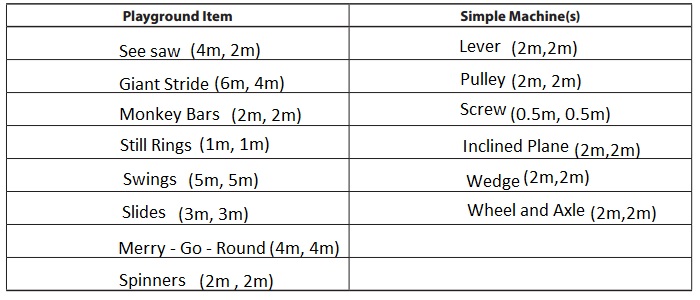
Play ground Items:
Area of See saw = 4 m X 2 m = 8 square meters,
Area of Giant Stride = 6 m X 4 m = 24 square meters,
Area of Monkey Bars = 2 m X 2 m = 4 square meters,
Area of Still Rings = 1 m X 1 m = 1 square meters,
Area of Swings = 5 m X 5 m = 25 square meters,
Area of Slides = 3 m X 3 m = 9 square meters,
Area of Merry – Go – Round = 4 m X 4 m = 16 square meters,
Area of Spinners = 2 m X 2 m = 4 square meters,
Simple Machines:
Area of the Lever = 2 m X 2 m = 4 square meters,
Area of the Pulley = 2 m X 2 m = 4 square meters,
Area of the Screw = 0.5 m X 0.5 m = 0.25 square meters,
Area of the Inclined Plane = 2 m X 2 m = 4 square meters,
Area of Wedge = 2 m X 2 m = 4 square meters,
Area of Wheel and Axle = 2 m X 2 m = 4 square meters,
The area of the whole play ground will be more than ( 8 + 24 + 4 + 1 + 25 + 9 + 16 + 4 + 4 + 4 + 0.25 + 4 + 4 + 4) square meters = 111.25 square meters,
Explanation:
Made a list of play ground items and list of simple machines above, Calculated and label the areas of as many playground items as I can, Calculated the area of the whole playground
which will be more than ( 8 + 24 + 4 + 1 + 25 + 9 + 16 + 4 + 4 + 4 + 0.25 + 4 + 4 + 4) square meters = 111.25 square meters.
Measuring the Playground
The city council of Waterton decided to build a public playground in the city park. They asked playground builders to give them prices for the project, and they included this drawing to help the builders come up with price estimates. The drawing shows how much space each piece of play equipment needs and groups them together in the space the city has available to use for the playground.
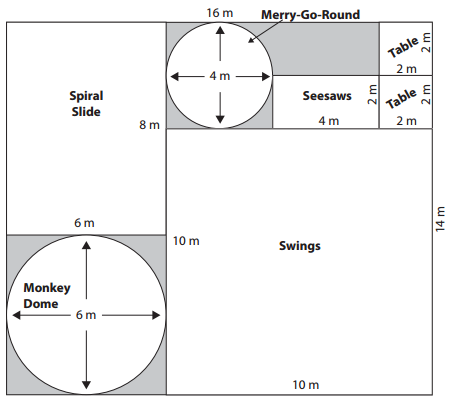
Question 1.
What is the total area of the playground (including space not used by any of the pieces of equipment)?
Answer:
224 sq m.
Explanation:
Area of a play ground A = Length X width,
l = 16 m; w = 14 m,
A = 16 m X 14 m,
A = 224 sq m.
Question 2.
The monkey dome only needs a circular space, but the city wants it to have a square sawdust pit.
a. What will the area of the sawdust pit be?
Answer:
36 sq meters,
Explanation:
Area of a Square = Side X Side
Given, side = 6 m.
A = 6 X 6
A = 36 sq meters.
b. What will the sawdust pit’s perimeter be?
Answer:
18.857 meters.
Explanation:
The Perimeter of the circle P = 2 π r
r is the radius of the circle.
We know that, π = 3.142
P = 2 x 3.142 x 3
P = 6 x 3.142
P = 18.857 meters.
Question 3.
One of the builders asked if the city would like the playground to be fenced. What length of fencing would they need to surround the whole perimeter of the playground?
Answer:
60 meters.
Explanation:
Perimeter of a play ground P = 2(Length + Width)
l = 16 m; w = 14 m
P = 2 (16 + 14)
P = 2 x 30
P = 60 meters.
Question 4.
Another builder suggested that the city add a sandbox to the playground. Where would you add the sandbox? Draw it on the plan and mark its dimensions.
Answer:
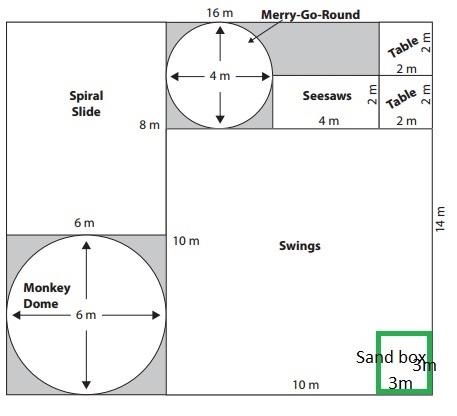
Sand box dimensions 3 m X 3 m,
Explanation:
As another builder suggested that the city add a sandbox to the playground. Added the sandbox, Drawn it on the plan and mark its dimensions are 3m X 3m as shown above.
Bridges in Mathematics Grade 4 Student Book Unit 8 Module 2 Session 2 Answer Key
Growing Grass
Javier recorded the amount of water he gave his grass and how high it grew.
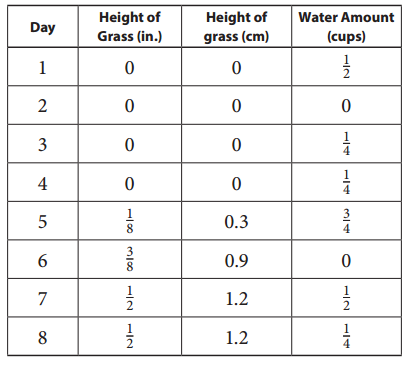
Question 1.
How much water has Javier given the grass so far?
Answer:
2 \(\frac{1}{2}\) cups,
Explanation:
From the above given table,
Javier has given water 2 \(\frac{1}{2}\) cups of water.
\(\frac{1}{2}\) + \(\frac{1}{4}\) + \(\frac{1}{4}\) + \(\frac{3}{4}\) + \(\frac{1}{2}\) + \(\frac{1}{4}\) = 2 \(\frac{1}{2}\) cups.
Answer the following questions in both inches and centimeters.
Question 2.
How much did the grass grow between day 5 and day 8?
Answer:
1.5 cm,
Explanation:
With reference to the above given table,
the initial height of grass on 5th day is \(\frac{1}{8}\) inches and on 8th day is \(\frac{1}{2}\) inches.
So, the grass grow between day 5 and day 8 = 0.3 + 1.2 = 1.5 cm.
Question 3.
Between which two days did the grass grow the most? How much did it grow?
Answer:
5th and 6th day,
The height of the grass between these two days, 0.6 cm,
Explanation:
With reference to the above given table,
the grass grows the most on 5th and 6th day.
So, the height of the grass between these two days,
0.9 – 0.3 = 0.6 cm.
Bridges in Mathematics Grade 4 Student Book Unit 8 Module 2 Session 3 Answer Key
Ranking by Another Class
One team from Ms. Li’s class calculated the following tallies of votes for their important playground items. Make a bar graph of their voting results.
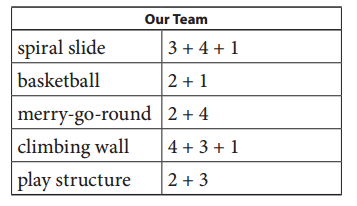

Question 1.
What items are most important to this team?
Answer:
Spiral slide and climbing wall,
Explanation:
With reference to the above given information, Spiral slide and climbing wall.
Number of votes for spiral slide = 8,
Number of votes for climbing wall = 8.
Question 2.
What items are least important to them?
Answer:
Basket ball,
Explanation:
With reference to the above given information,
Number of votes for Basketball = 3,
So, the least important item is Basketball.
Estimate & Reason with Jam
Question 1.
Every summer, June makes strawberry jam to sell at a farm market. Last year, June made $330 selling jam. This year the strawberry crop is very good, and June expects to make $440. June believes that with the extra income, she’ll be able to buy a new e-book (costing between $5.99 and $9.99) every month next year. Is she correct? Why or why not?
Answer:
She is correct,
Explanation:
Last year, June made $330 selling jam.
This year the strawberry crop is very good, and June expects to make $440.
Extra amount she is expecting $440 – $330 = $110,
Given, cost of new e-book (costing between $5.99 and $9.99),
If she want to buy e-book every month next year, the approximate cost = $118.8 even if buy with highest price. So, she can buy the e-book every month next years, if everything goes well.
Question 2.
Jack plans to buy 6 pints of June’s jam this year. The jam cost $4.50 per pint last year. He knows the price will probably increase this year. Jack estimates what he might have to pay for 6 pints of jam using the following expression:
(6 × 4.50) + (6 × i)
a. What does the i in Jack’s expression mean?
Answer:
i = $4.50,
Explanation:
Jack plans to buy 6 pints of June’s jam this year, The jam cost $4.50 per pint last year,
Jack estimates what he might have to pay for 6 pints of jam using the following expression:
(6 X 4.50) + (6 X i) = 24 + (6 X i),
i = 27 ÷ 6,
i = $4.50.
b. CHALLENGE If each pint of jam costs $6.25 this year, how much more will Jack pay for 6 pints this year than he paid for 6 pints last year?
Answer:
$10.5 more than last year,
Explanation:
If each pint of jam costs $6.25 this year, Jack pay for 6 pints this year = 6 x $6.25 = $37.5,
He paid for 6 pints last year = 6 x $4.50 = $27, Total amount he pay more than last year
$37.5 – $27 = $10.5.
Bridges in Mathematics Grade 4 Student Book Unit 8 Module 2 Session 4 Answer Key
Playground Costs
1. Gather and enter information about the cost of each playground item on your list.
- Use at least two different sources. Write all of your source names below.
2. As you research the prices of playground equipment, enter prices in the table below.
- Find and record two different prices for each item.
- Calculate and record the average price for each item.
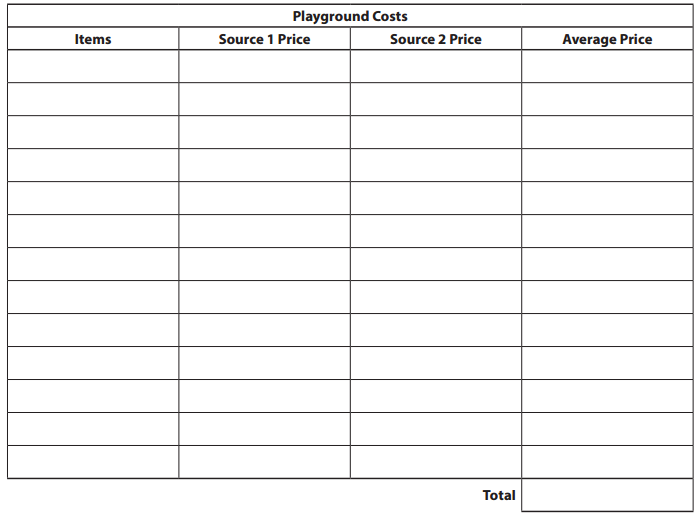
3. Calculate the total average price and enter it in the table. Show your work below.
Answer:
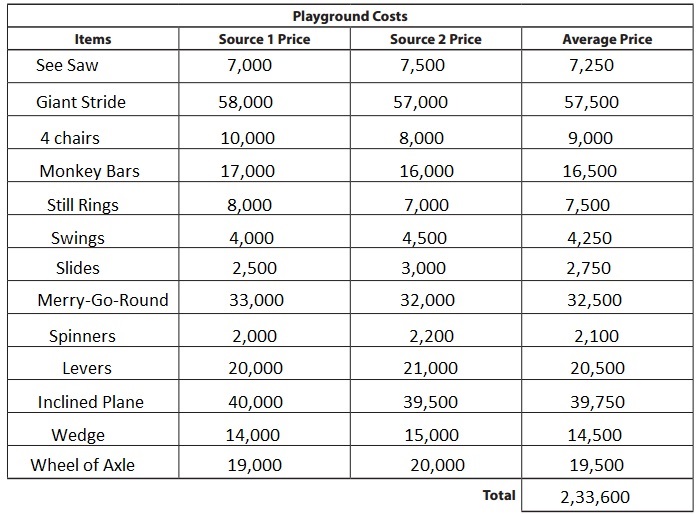
Explanation:
Gathered and entered information about the cost of each playground item on your list. Used at least wo different sources. Founded and recorded two different prices for each item. Calculated and recorded the average price for each item. Calculated the total average price and entered it in the table above.
Analyzing the Playground Costs
Look at the bar graph of the class’s total average costs.
Question 1.
What do you notice about the data? Describe at least two observations.
Answer:
Prices differ from source 1 and source 2,
Source 2 prices are less compared to Source 1 prices,
Explanation:
Noticed about the data are
1. Prices differ from source 1 and source 2,
2. Source 2 prices are less compared to Source 1 prices.
Question 2.
What is the range of the costs?
Answer:
Range = 55,400,
Explanation:
Range = highest value – lowest value, As highest is 57,500 and lowest is 2,100 so range = 57,500 – 2,100 = 55,400.
Question 3.
What is the mean of the costs?
a. Why is it useful to calculate the mean of the costs? How could you use this number to plan for the new playground?
Answer:
Mean of costs is 18,000,
By using mean we can easily analyze the data how much is costs per each item to plan for new playground,
Explanation:
Mean of costs is dividing the sum of all values in a data set by the number of values, as the total cost is 2,33,600 and number of items are 13 therefore it is 2,33,600/13 = 17,969.2 approximately 18,000, by using mean we can easily analyze the data how much is costs per each item to plan for new playground.
Question 4.
How does your total average cost compare to the class total average cost?
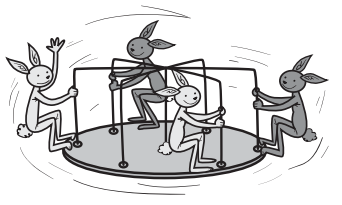
Answer:
Class total average cost data insufficient.
Bridges in Mathematics Grade 4 Student Book Unit 8 Module 2 Session 5 Answer Key
Analyzing the Results
Question 1.
What is the range of the survey data?
Answer:
Range = 55,400,
Explanation:
Range = highest value – lowest value, As highest is 57,500 and lowest is 2,100 so range = 57,500 – 2,100 = 55,400.
Question 2.
What is the mode of the survey data?
Answer:
Mode of the survey data : Observations collected data,
Explanation:
The mode of the survey data is by observations of collected data at one given point.
Question 3.
Compare the survey graph to the graphs of class data and team data. How do the graphs differ? How are they the same? Write at least two observations comparing the graphs.
Answer:
Graphs are same, data is almost same,
Graphs observations:
Data Insufficient.
Question 4.
What three items are most important to include in the playground design? Use the graphs to justify your answer. Explain your thinking using numbers and words.
Answer:
1. Design for different types of play,
2. Making room for secrets and surprises,
3. Create zones for different energy levels,
Explanation:
The three items that are most important to include in the playground design are 1. Design for different types of play, 2. Making room for secrets and surprises, 3. Create zones for different energy levels.
More Growing Grass
Javier continued to record the amount of water he gave his grass and how much the grass grew.
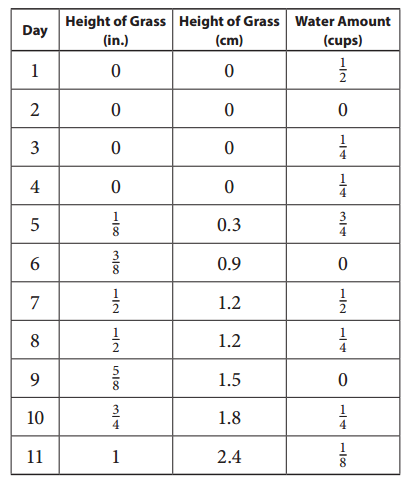
Question 1.
How much water has Javier given the grass since day 8?
Answer:
2 \(\frac{1}{2}\)
Explanation:
With reference to the data given above, water given to the grass till day 8
\(\frac{1}{2}\) + \(\frac{1}{4}\)+ \(\frac{1}{4}\) + \(\frac{3}{4}\) + \(\frac{1}{2}\) + \(\frac{1}{4}\)
= \(\frac{2}{4}\) + \(\frac{1}{4}\)+ \(\frac{1}{4}\) + \(\frac{3}{4}\) + \(\frac{2}{4}\) + \(\frac{1}{4}\)
= \(\frac{2 + 1 + 1 + 3 + 2 + 1}{4}\),
= \(\frac{10}{4}\),
= \(\frac{5}{2}\),
= 2\(\frac{1}{2}\),
Answer the following questions in both inches and centimeters.
Question 2.
How much has the grass grown between day 8 and day 11?
Answer:
2\(\frac{7}{8}\) inches or 6.9 cm.
Explanation:
With reference to the data given above,
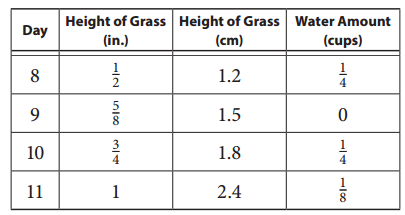
The grass grown between day 8 and day 11 in inches and centimeters
= \(\frac{1}{2}\)+ \(\frac{5}{8}\) + \(\frac{3}{4}\) +1,
= \(\frac{4}{8}\) + \(\frac{5}{8}\)+ \(\frac{6}{8}\) +1,
= \(\frac{4 + 5 + 6}{8}\) + 1,
= \(\frac{15}{8}\) + 1,
= \(\frac{15 + 8}{8}\),
= \(\frac{23}{8}\),
= 2\(\frac{7}{8}\) inches.
In centimeter = 1.2 + 1.5 + 1.8 + 2.4 = 6.9 cm.
Question 3.
How much has the grass-grown between day 6 and day 11?
Answer:
3\(\frac{3}{4}\) inches or 9 cm,
Explanation:
With reference to the data given above,
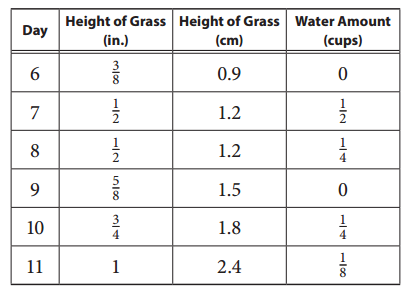
The grass grown between day 6 and day 11 in inches and centimeters.
= \(\frac{3}{8}\) + \(\frac{1}{2}\)+ \(\frac{1}{2}\) + \(\frac{5}{8}\) + \(\frac{3}{4}\) +1,
= \(\frac{3}{8}\) + \(\frac{4}{8}\)+ \(\frac{4}{8}\) + \(\frac{5}{8}\) + \(\frac{6}{8}\) +1,
= \(\frac{3+4+4+5+6}{8}\) + 1,
= \(\frac{22}{8}\) + 1,
= \(\frac{22 + 8}{8}\),
= \(\frac{30}{8}\),
= 3\(\frac{6}{8}\),
= 3\(\frac{3}{4}\) inches.
In centimeter = 0.9 + 1.2 + 1.2 + 1.5 + 1.8 + 2.4 = 9 cm.